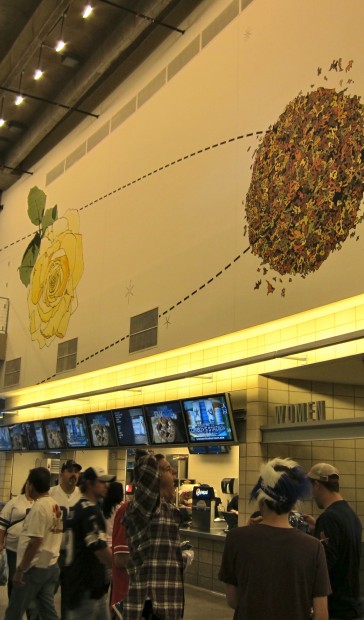
Dave Muller, "Solar Arrangement" (2009), acrylic on wall, approximately 21 feet by 131 feet, located in Main Concourse, NW Concession Area
I stand staring up at Solar Arrangement, Dave Muller’s sprawling mural at Cowboys Stadium. It’s 21 feet tall by 131 feet wide and extends over the bathrooms and the adjacent concession stands with their digital menus touting lipids and libations. Kanye West’s “Power” pulsates in the background. I’m trying to look at the art but the smell of the $20 Super 16-oz burger is calling.
It’s a moment of internal conflict, the sports fan in me yells, “What are you doing looking at art at a Dallas Cowboys game?” while the visual arts enthusiast in me, demands, “What are you doing looking at art at a Dallas Cowboys game?”
It’s just another Sunday at the palatial Dallas Cowboys Stadium otherwise unofficially known as Jerry World — in homage to their iconic, albeit megalomaniacal owner Jerry Jones.
Opened in 2009, the $1.2 billion stadium, which occupies 3 million square feet, defies the limits of any sporting venue built before, while simultaneously challenging future venues to step their games up to a stratospheric level. This isn’t a stadium, it’s a swanky spaceship fitted with bells and whistles formerly unimagined at a sporting locale.
Beyond the 286 concession areas and 1600 toilets, two interior features are what truly cement the stadium within a class of its own — the high-definition digital media board suspended 90 feet above the synthetic turf field and the 21 commissioned works of contemporary art installed throughout the facility.
1.2 million pounds — that’s the weight of the mammoth media board. When I first walked into the stadium it’s all my eyes allowed me to see. Measuring 160 feet wide and 72 feet high, it is the spaceship within the spaceship.
At one point during pre-game, the media board shows Cowboys tight-end Jason Witten seated at his locker with his back to the camera. As Witten finishes drinking his bottle of red Gatorade, he stands up and walks toward a different area of the expansive locker room. Just before Witten leaves the shot, viewers are given an awkward, voyeuristic opportunity to see two of his teammates get their pads properly buckled and their jerseys lowered. The screen projects images so large it’s like I’m standing right in front of them. I feel obligated to respect their privacy by taking a step back or turning away.
Later, the screen displays images of swimsuit models and the men around me quickly alert their friends to come “check this out.” Within seconds, I’m surrounded by arms extended in the air, camera phones in full effect. It puzzles me. They are actually going to look at these pictures of pictures again later?
I don’t mean to single out lustful dudes conspiring with camera phones, because we all have our vices. I’ve seen something similar in art museums — men and women taking pictures of things before they’ve even actually looked at the object. Thus, looking through the eye of the camera lens becomes their first and sometimes only encounter as they move on to the next object to digitally document.
Unfortunately, I failed to see any cameras extended towards the stadium’s art. With work by Franz Ackermann, Doug Aitken, Ricci Albenda, Mel Bochner, Daniel Buren, Todd Eberle, Olafur Eliasson, Teresita Fernandez, Wayne Gonzales, Terry Haggerty, Trenton Doyle Hancock, Jacqueline Humphries, Jim Isermann, Annette Lawrence, Dave Muller, Matthew Ritchie, Eva Rothschild, Gary Simmons, Lawrence Weiner and Garth Weiser, there is plenty of stuff worth photographing.
I asked a staff member if visitors ever stop and look at Terry Haggerty’s Two Minds, an expansive, optically-charged wall painting. He bluntly told me, “not at all.” However, he shared that he personally “loved” the work and added, “instead of blank walls, it gives people something nicer to look at.”
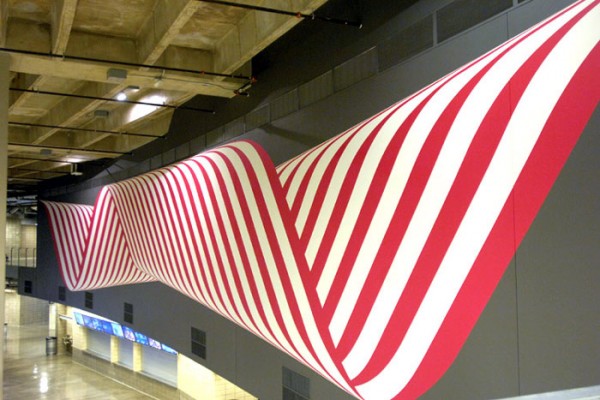
Terry Haggerty, "Two Minds" (2009), acrylic on wall, approximately 21 feet by 126 feet, located in Main Concourse, NE Concession Area
The care taken with placement and presentation of these works is museum-quality. Each is ready to be noticed, ready to engage the viewer. But it’s not enough.
I drove up from San Antonio for the explicit purpose of looking at the artwork, and I couldn’t even concentrate. No place to sit and reflect on the artwork. Certainly no silence. Each time a fan went to the condiment cart to load their hot dog, the smells of relish, ketchup and mustard wafted my way. I couldn’t even get under Annette Lawrence’s Coin Toss, a network of cables stretched tightly over the “Entry E” entrance. The Cowboys’ site says the sculpture “comes alive when one walks under it.” The sea of navy and silver wouldn’t part long enough to let me find out.
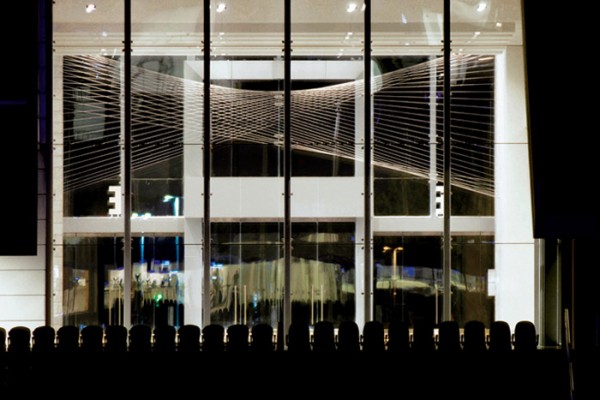
Annette Lawrence, "Coin Toss" (2009), stranded cable, 14 feet diameter by approximately 45 feet (span), located in Main Concourse, SE Entry
Besides, the most engaging work of art in the entire stadium is the looming digital monitor.
Admittedly, I didn’t comprehend how to properly navigate the main concourse level. I thought one could walk in a complete circle around the stadium, but when I asked a guest relations staff member how to get over there — pointing to the opposite end zone — she looked as puzzled as I was. Segments of the main concourse are dedicated to “Main Concourse Clubs” that can only be accessed by individuals with “Suite” tickets.
In other words, it seems as though you can’t even see some of the works of art unless they’re located near the gate you’re supposed to enter through or you have a certain priority ticket that grants admittance to areas that aren’t available to the entire ticketed public.
Three years ago, in 2008, when the Dallas Cowboys played their final season at the nearly 40-year-old Texas Stadium in Irving, the average ticket price was approximately $84, according to Team Marketing Report, a leading publisher of sports marketing figures. However, the average ticket price for a Dallas Cowboys fan increased by 90%, up to a league-leading $160, when the new Dallas Cowboys Stadium was opened in 2009.
The September 2011 Team Marketing Report listed the Dallas Cowboys average ticket price at $110, unchanged from 2010’s report and fourth highest in the league — behind the New York Jets, New England Patriots and New York Giants. That being said, the Fan Cost Index (FCI) of the Dallas Cowboys remains the second highest in league at $613.80 — nearly $200 above the league FCI average of $427.
The FCI calculation is based on the cost of four average-priced tickets, two small draft beers, four small soft drinks, four regular-sized hot dogs, parking for one car, two game programs and the two least expensive, adult-sized adjustable caps. Based on those numbers, if Joe Cowboy Fan is shelling out $600 for his wife and two kids to see the game at Cowboys Stadium, he’s hemorrhaging around $240 an hour. How much of that time is he going to want to spend looking at art?
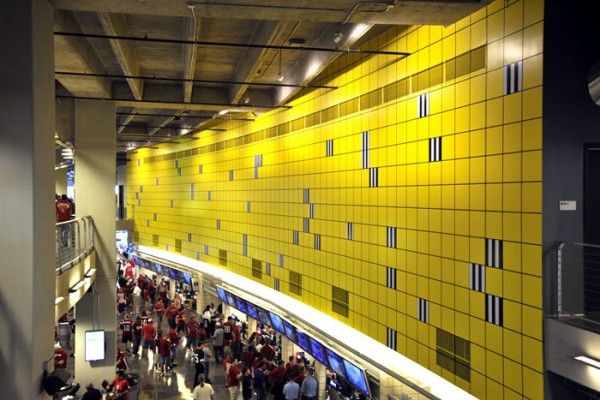
Daniel Buren, "Unexpected Variable Configurations: A Work in Situ" (1998), wall painted yellow with hand-drawn grid and 25 screen-printed aluminum plates, edition 10 of 15 and 11 of 15, approximately 21 feet by 118 feet, located in Main Concourse, SE Concession Area
While bringing cutting-edge contemporary art to a new audience is commendable, there’s nothing remotely populist about this superficially populist gesture. It feels more like a justification for increasing ticket prices than something that is supposed to possibly inspire and engage visitors.
But hey, guess what, there’s a Plan B if you don’t have hundreds of dollars to spend at a football game, but want to see the art. Visitors can take an “Art Tour” — audio on Monday/Wednesday and guided on Tuesday/Thursday. The audio tours begin at $13 for students who bring their own iPad, iPhone, or iTouch with the downloaded Art at Cowboys Stadium App. They’re $16 for adults who require rental of a stadium-provided device. Guided tours are $22.
Keep in mind, there are only 21 works of art to see on the “Art Tour,” but c’mon — at least you’re in the spaceship! On the other hand, Dallas-Fort Worth is home to several world-class museums: Dallas Museum of Art ($10), Modern Art Museum of Fort Worth ($10), the Kimbell (Free), the Amon Carter (Free) [and the Nasher! ($10)].
Why can’t someone who paid for a game ticket then use that as a free voucher to take an “Art Tour” within the next 30 days? Better yet, why can’t the price of an “Art Tour” be cheaper than or on par with the cost of visiting Dallas-Fort Worth’s esteemed museums?
When I tried to ask fans about the art, the first person I approached prior to Sunday’s kickoff against the Rams shot me down quickly: “I’m just here for the sports, man.”
I can’t disagree with that sentiment. Can you?
Visiting Dallas Cowboys Stadium as a non-fan is an exercise in ambivalence. I might be able to convince myself that if I were a fan of “America’s Team,” I would be able to look beyond the ridiculousness of it all. I’d see Jerry World for what its namesake probably intended — a destination for sports and culture rather than merely the location of a football game.
But I can’t get past the hollowness of the experience. Then again, every professional arena gouges people and at least Jerry Jones is aesthetically elevating the experience of waiting in lines for concessions, waiting outside bathrooms and filing in through the entrance.
Does anyone actually consume the artwork at Dallas Cowboys Stadium on a Sunday game day?
Depends — if you count the $6 souvenir cups that display Dave Muller’s Solar Arrangement, then they sure do.
_______________
Ryan Sachetta writes his bylines from San Antonio. When not correcting the pronunciation of his name – ‘suh-ketta’ – he is in perpetual awe of Tim Duncan’s bank shot and Roger Federer’s forehand. His relationship with the visual arts began when he saw Glenn Ligon’s Lest We Forget series at the Blanton.


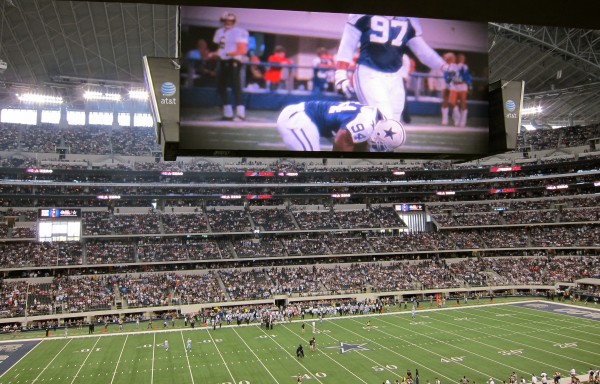


14 comments
Well said Ryan, even though I’m happy Mrs. Jones demanded art be on the walls. Most “public art”(though I’m not sure this qualifies as public art really) goes unnoticed amongst whatever other activity is happening around it, especially in the context of a Dallas Cowboys game for Christ’s sake.
I did find it reassuring, however, that even if art is ignored amongst hot dogs and boobs, the fact that it’s there in the ambiance of a place makes a comforting point — I wasn’t there to see art (unless you want to call Monster Jam at Cowboys Stadium performance art, but that’s a different essay) but because it was there, I felt better. Walking past Grave Digger at the Pit Party then seeing work by Trenton Doyle Hancock somehow was a well-rounded experience for me.
It makes me think of the Islander Art Gallery in Corpus Christi, the A&M CC University art space that is situated in a strip mall right next to a Family Dollar. Art in culturally contrasting spaces might be the future of art. Or not. I feel a follow-up essay coming on…
Great article, Ryan! I had no idea there was so much artwork in the Cowboy’s stadium. $22 for a guided tour?! No wonder no one is paying any attention to the art…
Hi Ryan!
I am so glad you visited the stadium to see the art and so glad you visited on a game day. It is an awesome collection on a private tour, but since you were there on a game day you were able to see the full intent of its presence there. Great pains were taken to select the artists,commission the works and install them.The works certainly do elevate this stadium to a level of sophication not found in others and provide those sports fans who also appreciate art a level of comfort in going.When Super Bowl was here on staduim opening each of these artist also had shows at the DMA-there were special tours available to view both before game day. That was truly a memorable journey.Some of the artist were also available to talk about their selection process,commission and installation of their pieces. I hope you can return for a private tour.
Oh-you did not mention the Nasher-another of our outstanding museums here in Dallas. I hope you can visit it also on your return.
Kind regards,
Carla
Well put! I think this eloquently says so much without stating it point blank. And sure do wish game day attendees are reading away! I might just leave copies in their drink holders. Great work!
Great piece, Ryan. Really interesting idea regarding this world class art in a world class stadium, with no proper way to enjoy it. Seems like a great concept that really missed the mark. Hope that the Cowboys can recognize this lack in execution and work with local museums/community programs to find new and creative ways to attract visitors and display the artwork.
Oh Alex-I hope you will read my prior comment-the stadium has done this. On occasion they have opened their private box for lunch and or cocktails after tours that involved the Dallas Museum of Art.They have been quite interested from the start in getting the word out to institutions,schools and special interest groups.
Is the reason that the male heavy artist line-up featured at the stadium is because they play football there?
[…] on Glasstire there is an interesting take on the art installed at Dallas Cowboys Stadium, which takes up a question that was still left open […]
[…] on Glasstire there is an engaging article on a art commissioned during Dallas Cowboys Stadium, that takes adult a doubt that was still left […]
[…] on Glasstire there is an interesting article on the art installed at Dallas Cowboys Stadium, which takes up a question that was still left open […]
So glad to be able to read about this project. Thanks Ryan and Glasstire, for getting the word out.
I get the point about fake populism, but don’t think the Cowboys’ Stadium situation is any different from other more-or-less public art projects. Some elements are in places where access is wide open, others have limited accessibility. The comparison that comes immediately to mind is the International Terminal at D/FW airport. Overall, this is an exciting idea that appears to be well-executed.
This idea of art in commercial spaces isn’t exactly new. Ray Nasher, pioneered that concept long ago in Dallas. No… It’s not the Nasher — it’s called Northpark. And you can see it all for free.
Carla Hollis is happy that “They have been quite interested from the start in getting the word out to institutions, schools and special interest groups.”
School groups can visit any of DFW’s world-class museums, as well as other contemporary-art venues like the Rachofsky House for FREE. It’s hard to believe that many schools would pay $$$ for their students to see art owned by one of the world’s richest men, when they could go to the Kimbell, the Nasher, the DMA, or the Modern for FREE.
Dear Ryan, Your article and the photos were fabulous! We’re proud of your skills and abilities to communicate wonderfully well!